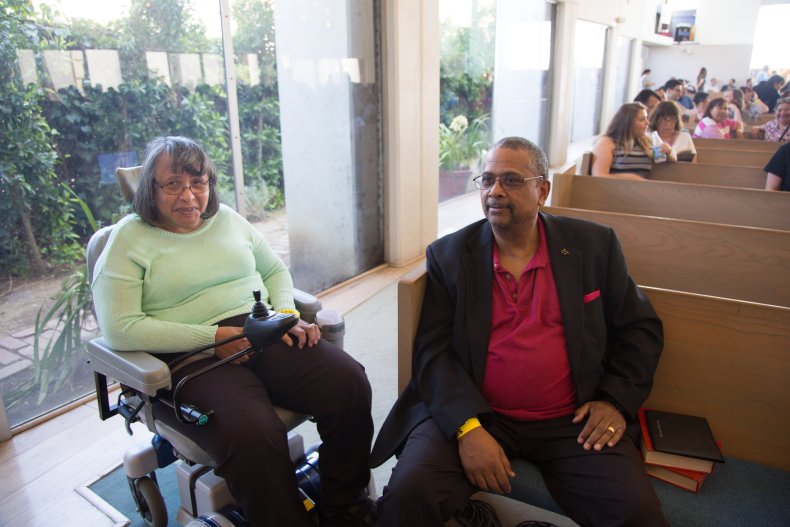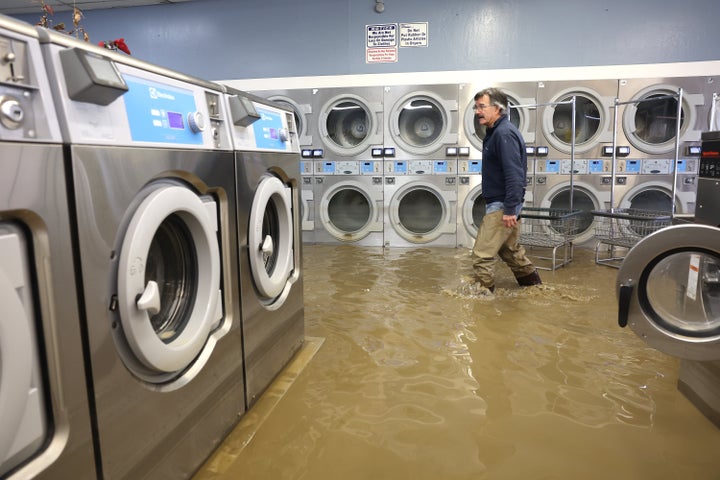It’s possible that I shall make an ass of myself. But in that case one can always get out of it with a little dialectic. I have, of course, so worded my proposition as to be right either way (K.Marx, Letter to F.Engels on the Indian Mutiny)
Sunday, April 23, 2023
Angelo Carusone: They are “taking an already simmering cauldron of anxiety, of fear, of hate, of rage, and they are ratcheting up that temperature, bit by bit.”
WRITTEN BY MEDIA MATTERS STAFF
PUBLISHED 04/22/23 8:38 PM EDT
Citation From the April 22, 2023, edition of MSNBC's American Voices with Alicia Menendez
ALICIA MENENDEZ (HOST): Angelo, I am so glad that Andy reminded us that 1/6 is a part of this continuum here. Philip Bump at The Washington Post reports, quote, "Fox News's coverage since mid-2020 has disproportionately involved clips of isolated criminal activity to generate a sense of unconstrained violence in urban areas -- despite evidence that the increase in crime since the pandemic also occurred in rural areas." You touched upon that, but what I want to come back to is the fact that this week, you had the GOP-led House leading a field hearing about crime in New York City, which then Fox News covers, and it just becomes part of this endless feedback loop where the circus becomes reality.
ANGELO CARUSONE (MEDIA MATTERS PRESIDENT AND CEO): Yeah, and I think the part that concerns me the most is -- I think, that it's one thing when it's just a misinformation, feedback loop, that itself is a problem, but in a way, it's actually less scary than the current scenario because a couple of years ago -- and now, it's really just fully formed -- there was a switch. And basically the Republican party, via the right-wing media, decided that they were going to organize power on what used to be considered the fringes. And so once they sort of moved those fringe and set them right and directly front and center in the Republican core, it actually basically pulls in people that are most likely to act on these types of ideas, on this misinformation feedback loop. So what they're basically doing is taking an already simmering cauldron of anxiety, of fear, of hate, of rage, and they are ratcheting up that temperature, bit by bit. And so every time they sort of misrepresent, missample the threat of crime, who's actually responsible, that it's coming for you, they are basically raising the temperature on that cauldron. So it shouldn't be a surprise that it's increasingly starting to spill over and boil over. It's kind of what they're doing. They are organizing power on the fringes. This is what you get when you move the fringes front and center.
3,000 migrants begin protest march in Mexico

Roughly 3,000 migrants have begun a protest procession through Mexico toward Mexico City to demonstrate against detention centers and demand reforms to migrant treatment.
The march of migrants — hailing mainly from Central America, Cuba, Venezuela, Ecuador and Colombia — started Sunday near the Guatemalan border. Though their stated destination is Mexico City, participants in similar marches have, in the past, headed further north to the U.S.-Mexico border.
The latest protest march comes after a deadly fire last month killed 39 migrants and injured 29 others at a Mexican migrant facility in Ciudad Juarez, across the border from El Paso, Texas.
Mexican President Andrés Manuel López Obrador said migrants at the facility had set fire to their mattresses as part of a protest against a supposed transfer.
Three officials from Mexico’s National Immigration Institute, a guard at the migrant center and the Venezuelan migrant accused of starting the fire are reportedly in custody, facing homicide charges.
The Associated Press contributed to this report.
A man who spent 20 years in prison for a crime he didn’t commit is now running for Congress in Southern California.
Francisco “Franky” Carrillo was wrongly convicted of committing a 1991 murder at the age of 16 and spent two decades in prison trying to prove his innocence before being exonerated in 2011. Now, he is running against Rep. Mike Garcia (R-Calif.) in California’s 27th District as a Democrat.
Carrillo is a member of the Probation Oversight Commission in Los Angeles and works with the LA Innocence Project. He was elected to a position in the Los Angeles County Democratic Party this year.
The 27th is a key swing district in California. Spanning from Santa Clarita to Lancaster, across the San Gabriel Mountains from Los Angeles, it is one of just 18 districts which elected a Republican to the House in 2022 after voting for President Biden in 2020.
Cook Political Report named the district one of the most competitive in the country for 2024.
Garcia is a Trump ally, and was one of the 147 congresspeople who voted to reject the results of the 2020 election.
In a video announcing his run, Carrillo positioned himself as a candidate that looks out for the interests of the average Californian, lambasting what he characterized as the unfair impact of rich and powerful people such as Fox Corp. owner Rupert Murdoch, pharmaceutical executive Martin Shkreli and Twitter CEO Elon Musk.3,000 migrants begin protest march in MexicoTrump suggests Putin ‘got a little more ambition’ after US withdrawal from Afghanistan
“There are people who abuse their power and benefit from the system. Then there’s the rest of us, who play by the rules and get screwed by the same exact system,” Carrillo said.
“The people who rig the system — the big CEOs, the hedge fund managers, the big corporations which jack up our prices — they get exactly what they want,” he added. “Meanwhile, we get screwed by the insurance companies, drug companies, oil companies and those politicians who they put in power.”
He called Garcia a “MAGA extremist” and “part of the problem.”
The company has already gutted its development team for the campus
Rising interest rates and fears of a recession have forced cuts at Alphabet
By STEPHEN M. LEPORE FOR DAILYMAIL.COM
PUBLISHED: 23 April 2023
Google is halting construction on its 80-acre campus in San Jose with no plans to pick it up again in the 'near future,' as they begin a series of layoffs and cost cutting measures.
The Google village, named Downtown West, would have included shops, restaurants, a hotel, and cultural and entertainment hubs, as well as potentially acting as the campus for 25,000 Google employees.
The company gutted its development team for the campus - which they said would have an economic impact of $19billion - earlier this year in a series of downsizing efforts as the economy gets worse for big tech.
Rising interest rates and fears that the country is on the brink of a recession have forced the cuts.
The plan was to break ground on the site before 2023 ended but it was paused after worries of delays at the start of the year, with no plan to begin again.

Google is halting construction on its planned 80-acre campus in San Jose with no plans to pick it up again in the 'near future' as they begin a series of layoffs and cost cutting measures
San Jose councilmember Omar Torres, who represents the area, was concerned about the rumors.
'We all originally knew that it's going to be a long-term plan,' Torres said in February. 'But yes, it's definitely concerning that a lot of the money is coming when the cranes are in the air.'
CNBC reports that sources are 'optimistic' that the campus will eventually be built, although it may have to be scaled back.
LendLease, the project's lead developer, made 67 layoffs in February, including of community engagement managers.
In a statement, a LendLease spokesperson said they remain 'committed in the creation of thriving mixed-use communities in the Bay Area, including the Google developments,' and still has a 'significant team to aid in delivering these communities.'
In March, Google took construction updates on the campus off of its website.
Two months earlier, the company announced the cutting of 12,000 jobs, representing about 6 percent of its workforce in order to deal with slowing sales growth following record growth in its headcount.
Google's finance chief, Ruth Porat, penned a rare company-wide email explaining how the tech giant is introducing measures to cut employee services in an effort to reduce expenses.

The Google village, named Downtown West, would have included shops, restaurants, a hotel, and cultural and entertainment hubs, as well as potentially acting as the campus for 25,000 Google employees

The plan was to break ground on the site before 2023 ended but it was paused after worries of delays at the start of the year, with no plan to begin again

An artist's sketch of Google's Downtown West development in San Jose. The company submitted new plans in 2021
The company's goal for 2023 is to 'deliver durable savings through improved velocity and efficiency.'
Porat detailed how Google is cutting back on everything from fitness classes for its employees to office basics from staplers and tape while also reducing the frequency of laptop replacements for its workers.
Google submitted its initial application to the San Jose planning division on October 10, 2019.
'We embrace this vision not because it's Google's, but because it encompasses the aspirations for a vibrant, dynamic downtown that our community has long held, as generations of San Joseans have sought to create a regional destination reflective of our authentic, diverse character,' San Jose Mayor Sam Liccardo said back in 2021, according to Mercury News.
'Particularly amid all the challenges of this pandemic, I'm grateful for the persistent collaboration between Google and city staff to enable our community to benefit from thousands of jobs, affordable apartments, vibrant retail and restaurants, public plazas, and park space.'

The company submitted the more detailed plan in 2021 which showed its idea for the green spaces and parks in the area. At least 30 acres if the total 55 acres will be for homes and public spaces, according to the current plans

Google's detailed plan showing how the area would maintain 'core character'

The company has also planned for cultural and entertainment hubs on the development

The improved plans detailed the zoning for the development. A decision will not be made by the city until next year
'We're excited about this next step in our project, which incorporates feedback from thousands of people over the last two years and provides another opportunity for community input,' added Alexa Arena, Google's development director for San Jose, at the time of the plan unveiling nearly two years ago.
The Downtown West area in San Jose was set to cover 80 acres, 55 of which can be developed. Of this, 30 acres would be for housing and public spaces.
Within the plan, Google agreed to work with the city to ensure that 25 percent - 4,000 - of the homes in the Diridon Station area will be affordable.
'We continue to hear that housing and preserving affordability is a priority for San Jose, and our proposal offers more affordable housing, job pathways and community spaces for San Joseans,' Arena said.

Google CEO Sundar Pichai
The development was also asked to blend into the surrounding neighborhoods instead of acting as a stand-alone tech campus.
'Downtown West is designed to be a true part of the city, the opposite of a traditional corporate campus,' said Laura Crescimano, founder of SITELAB urban studio, the project's lead urban designer.
'The draft design standards and guidelines published today set out the roadmap for a resilient and connected Downtown West.'
And historical buildings and natural features in the area were also required to be incorporated into the plan.
'Our team worked with Google to draw on the uniqueness of the location to propose a place where urban life and nature can coexist,' Crescimano said.
'We've brought together new and historic buildings, opportunities for arts and culture, playful spaces, and moments of respite along the Creek.'
According to the draft environmental impact plan submitted in 2021, the project would not create any net additions in greenhouse gases.
The company said that the new buildings they develop will be nearly 100 percent electric and 65 percent of travel would involve mass transit, bicycling and walking.
The plan included the ability for Downtown West to generate 7.8 megawatts of on-site solar energy as well as feature its own local microgrid.
Google's plan was welcomed by city officials who say that the 'city-within-the-city' will be of enormous benefit to residents.

The estimated timeline for the project as of Wednesday. The final environmental impact report will be submitted by this winter and a decision could be made by summer 2021 if the review is not pushed back further because of the pandemic
'This is the next level of development for San Jose,' said Scott Knies in early 2021, executive director of the San Jose Downtown Association.
'You have the housing, the affordable housing, and certainly the offices are there. But you also have the extraordinary combination of open spaces and cultural uses that makes it really unique.
'This is like a city within the city,' Knies added. 'Downtown West will not be a forest of high buildings. It's darn impressive.'
'At a time when so much in our world is on pause due to COVID, it's heartening to know that San Jose's most significant long-term urban development project is on track and hitting a key milestone' with the filings, Deputy City Manager Kim Walesh said.
The project was not without its critics, however, as some locals fear that it will displace working families and communities of color amid the pandemic.
'The pandemic has made the biggest concerns from the community about this project — preventing displacement, adding affordable housing, and ensuring quality jobs for working families and communities of color — even more critical,' said Maria Noel Fernandez, campaign director with Silicon Valley Rising who are fighting again the plan.
LOUIS JAMES , MEMBER OF SEIU 2015,
ON 4/21/23
When I married 37 years ago, I planned to travel the world with my beautiful wife Tina. What I didn't anticipate was how life's challenges would impact our adventures.
I became the primary caregiver for my wife 14 years into our marriage, when she became a quadriplegic. She relies on a motorized wheelchair, and I worry about having adequate support services when traveling through our nation's airports.
We take nonstop flights to avoid long waits for assistance and hectic rushes to the next terminal. There's not much we can do to make sure Tina's wheelchair is consistently handled properly at the airport. Wheelchair and mobility devices are often dismantled before being stowed in the cargo section of the plane. On a good trip, Tina's $30,000 wheelchair will be returned in the same condition as when it was handed to a baggage attendant. But other airport travelers may not be so lucky.
This is one of the reasons why I'm one of many SEIU members urging Congress to pass the Good Jobs for Good Airports Act (GJGA). I'm proud to support this legislation because it will help stabilize air travel and make airports more accessible for passengers like my beautiful wife.

Staffing turnover and training have recently been cited by the U.S. Government Accountability Office as one of the driving forces behind inconsistencies in wait times for wheelchair assistants and other barriers for flyers with disabilities.
Good Jobs for Good Airports would help address these issues by establishing wage and benefit standards for cabin cleaners, wheelchair attendants, and other covered airport service workers.
Far too often, this service workforce isn't paid enough to support their families or pay bills. As many airlines' profits increase, many of these workers have no employer-sponsored healthcare, no paid sick days, and inadequate protections on the job. As a result, many airports are chronically understaffed and unprepared to handle skyrocketing travel demands efficiently.
A new report from the Center for American Progress found that employee turnover rates significantly improve at airports and other places of employment that adopt wage standards similar to those included in the GJGA.
I would consider passage of the GJGA to be a big win because understaffing not only hurts travelers with disabilities; it hurts airport workers like Rio Bryant. Rio works as zone lead in the wheelchair department at the Hartsfield-Jackson Atlanta International Airport, where he sometimes works 70 to 80 hours a week just to make ends meet. At a recent press conference on Capitol Hill, he told lawmakers, "I know my job is really important, but I don't feel airlines value or respect us for the work we do."
While traveling for meetings and other events, I can't help but notice workers like Rio who are often overlooked, even though they're vital to keeping things running. Much like the home care industry, the aviation service workforce is powered by largely Black, brown and immigrant workers.
The pandemic has shown us that low wages and poor working conditions are fueled by systemic racism. Sadly, wages for many airport service workers across the industry have remained stagnant for nearly 20 years.
Airlines benefit from billions of our tax dollars spent on the aviation industry every year. Under the GJGA Act, we could rest assured that more of our public resources would serve the public good and lift up working families.
This bill is a win for people with disabilities and the care providers who love them. And it's a win for workers whose professionalism and kindness help me and Tina travel with dignity.
This is a thank you to the baggage handlers who followed my carefully-written instructions for handling Tina's wheelchair in recent years and the airport workers who went above and beyond to track down an eye-glass repair kit when a screw came loose in my wire-rimmed glasses.
As someone born with Spina Bifida, Rio says he understands the frustration travelers feel when they have to access the support they need. "When you have a disability, you do not want people to feel sorry for you and you don't want to be discriminated against because of how you may look or your abilities. However I see this happening all the time."
If airlines and members of Congress really care about ensuring our nation has a safe, efficient functioning aviation system that benefits every person regardless of their race, economic status, or ability, they should prioritize getting the Good Jobs for Good Airports bill to President Biden's desk.
Louis James is a member of SEIU 2015 and a "never-retired" pastor. He lives in Los Angeles, California.
The views expressed in this article are the writer's own.

A popular right-wing preacher said this week at a "Pastors for Trump" event that the people in his movement want to establish a theocracy—saying that they believe God should "take over the government."
Former President Donald Trump has long drawn substantial support from evangelicals as well as other conservative Christian groups. "Pastors for Trump" was launched in December by Pastor Jackson Lahmeyer, with the newly formed organization saying at the time that it had chapters in every state and included Christian leaders representing some 200,000 congregants.
Speaking at Lahmeyer's Tulsa, Oklahoma, church during a Wednesday event for the pro-Trump organization, right-wing activist and speaker Sean Feucht explained that their movement is advocating for God to "control everything." He also embraced the label of Christian nationalism, as have a number of prominent pro-Trump conservatives.
"It's all part of the king coming back. That's what we're practicing for," Feucht told the crowd in attendance, according to a video clip first shared by Right Wing Watch on Friday. "That's why we get called 'Christian nationalists.'"
The pro-Trump preacher continued, adding that critics say: "You want The Kingdom to be the government." He then responded enthusiastically, "Yes!"
"You want God to come on over and take over the government?" he asked, again representing the arguments of his movement's critics. "Yes!" he responded with excitement.
"We want God to be in control of everything! We want believers to be the ones writing the laws! Yes! Guilty as charged," Feucht said. He added that, "We wouldn't be a disciple of Jesus if we didn't believe that."
Trump's Firm Support from Conservative Christians
Trump drew the support of about 80 percent of white evangelical Christians in the 2016 presidential election. This trend was repeated in 2020, with surveys and exit polls showing between 76 and 81 percent of the religious demographic backed the former Republican president, NPR reported. In addition to evangelicals, Pew Research Center data showed that a majority (63 percent) of white Catholics who regularly attend mass backed Trump in the last presidential election.
Meanwhile, prominent Republicans, such as Representative Marjorie Taylor Greene of Georgia, have proudly embraced the "Christian nationalist" label. Greene has sold shirts with the label as part of her political fundraising.
"There's nothing wrong with leading with your faith...If we do not live our lives and vote like we are nationalists—caring about our country, and putting our country first and wanting that to be the focus of our federal government—if we do not lead that way, then we will not be able to fix it," the GOP lawmaker said at the Turning Point USA Student Action Summit last July.
What Is Christian Nationalism?
Paul D. Miller, professor of the practice of international affairs and co-chair for global politics and security at Georgetown University, explained in a 2021 article for Christianity Today that "Christian nationalism is the belief that the American nation is defined by Christianity, and that the government should take active steps to keep it that way."
Miller continued, writing that the movement asserts "that America is and must remain a 'Christian nation'—not merely as an observation about American history, but as a prescriptive program for what America must continue to be in the future." Christian nationalists, "believe that Christianity should enjoy a privileged position in the public square."
Separation of Church and State in the Constitution
Critics of the movement view it as dangerous and antithetical to the Constitution, which outlines a separation of church and state. This concept is established in the First Amendment of the Bill of Rights.
"Congress shall make no law respecting an establishment of religion, or prohibiting the free exercise thereof; or abridging the freedom of speech, or of the press; or the right of the people peaceably to assemble, and to petition the Government for a redress of grievances," the amendment says.
The First Amendment is generally interpreted to mean that Americans—lawmakers, un-elected government officials and ordinary citizens alike—are entitled to hold any religious belief they choose. It also guarantees that one particular religion is not favored by the government over another.
Many prominent Trump supporters and other conservatives have been openly campaigning against this established constitutional concept. Meanwhile, Republican lawmakers in states across the country have been pushing forward laws that appear to challenge the separation of church and state.
Conservative Christians Impact on Politics
In Texas this week, the GOP-controlled state Senate passed a bill that would require the Ten Commandments from The Bible's Old Testament to be displayed in public schools. The law would also set aside time in the school day for prayer and religious study. Laws restricting access to abortion as well as others targeting LGBTQ+ individuals have largely been pushed forward by conservative lawmakers and Christian activists—some of whom openly embrace Christian nationalism.
"When Christians essentially say, we wouldn't be disciples of God if we didn't want political power, I am afraid they are talking about a God they have crafted in their own image, and not the God of the Gospel," Dr. Heather Thompson Day, a Christian author, speaker and associate professor of communication at Andrews University, told Newsweek on Saturday.
She said that the example of Jesus was the opposite of seeking power and control. "They tried to make him king, and he wasn't interested in earthly thrones," Thompson Day said. "There is difference between seeking 'Christian power,' and revealing the power of God through Christians."
Reverend Nathan Empsall, the executive director of Faithful America, told Newsweek on Saturday that Feucht should read the Gospel of Luke and remember that Jesus rejected earthly power when it was offered to him.
"When self-identified Christian nationalist leaders like Sean Feucht say they want a Christian nation, it doesn't just mean they want to seize power for far-right politicians like Donald Trump or Ron DeSantis by any means necessary. It also means denying religious liberty and civil rights to non-Christians, progressive Christians, the Black church tradition, LGBTQ people, women, and other targeted communities," he said.
Trump, who launched his 2024 GOP presidential bid in November, is currently the frontrunner for his party's nomination. DeSantis, the governor of Florida who has championed state legislation restricting abortion and targeting the LGBTQ+ community, has not yet announced an intention to challenge Trump, but is generally seen as his most formidable contender for the Republican nomination.
Recent polling carried out in March by Monmouth University showed that Trump remains the favorite of evangelicals, however. The former president was backed by 44 percent of evangelicals and DeSantis was supported by just 25 percent.
MAGA Pastor Says Christians Must ‘Be the Ones Writing the Laws’
BY TIM DICKINSON
ROLLING STONE
APRIL 21, 2023

The MAGA preacher Sean Feucht made an unsettling guest appearance in the Tulsa, Oklahoma church of Jackson Lahmeyer, founder of Pastors for Trump, the leading group of evangelicals supporting the former president’s reelection bid.
Standing on stage at Sheridan.Church on Wednesday, Feucht made a direct call for Christian nationalism — declaring that America should be governed according to biblical law for the benefit of believers, as a way to prepare for the second coming of Christ.
“It’s all part of The King coming back,” Feucht told the audience. “That’s what we’re practicing for,” he insisted, before adding, “That’s why we get called ‘Christian nationalists.'”
Feucht then presented an imaginary dialog, in which he mockingly imitated the voice of secular critics: “You want The Kingdom to be the government,” he said, before thundering a reply in his own voice: “Yes!”
“You want God to come on over and take over the government,” he said, responding, again: “Yes!
Fuecht continued, now using his voice alone: “We want God to be in control of everything! We want believers to be the ones writing the laws! Yes! Guilty as charged.”
Presenting an extreme theology, one that is a far-outlier in Christian circles, Feucht added that Christian nationalism is required of the faithful: “We wouldn’t be a disciple of Jesus if we didn’t believe that.”
But Feucht has, in the past, been somewhat more circumspect. He has opted for heavenly calls of intervention and guidance in government — praying for the casting out of demons from Washington — rather than advocating for an overt takeover of politics by Christian zealots.
Feucht’s appearance at the church of Donald Trump’s top evangelical cheerleader raises questions about the ex-president’s 2024 campaign, and the role of Christian nationalists in shaping policy for a prospective second term. (Privately, as Rolling Stone has reported, Trump has been calling on religious zealots in his camp to keep a lid on the issue of abortion.)
After this story was first published, Lahmeyer sent an email to supporters titled, “The Rolling Stone Is After Me, Sheridan.Church & Sean Feucht… AGAIN!” In the body of the email, Lahmeyer characterized this article as part of “the constant attack” waged against “authentic Christianity” in America. He called on the faithful “to engage to preserve our Christian Nation” by acting to “make sure that President Trump is elected for a third time in 2024” — a reference to the baseless conspiracy theory that Trump won the 2020 election. Lahmeyer insisted that ex-“President Trump has proven to be a friend of the Church in America.”
Feucht is currently on a fifty-state worship tour to bring his now-open brand of Christian nationalism to every state capitol in the land. That tour has the backing of Turning Point USA, the far-right political shop headed by Charlie Kirk. Its initiative TPUSAFaith has partnered with Fuecht’s Let Us Worship project to stage the Kingdom to the Capitol tour.
The tour kicked off in Washington, D.C., last month, with a prayer service in the Capitol rotunda, surreptitiously organized by Boehbert.
PAUL SACCA
Officials in Texas are bewildered by several cattle that mysteriously had their tongues and genitalia removed. There was no blood or signs of struggle anywhere near the dead cattle.
This week, six cattle were found dead under mysterious circumstances across Madison County, Texas. Ranchers first found a 6-year-old longhorn-cross cow "lying on her side, deceased, and mutilated on their ranch."
The Madison County Sheriff's Office issued a statement regarding the suspicious cattle deaths.
"A straight, clean cut, with apparent precision, had been made to remove the hide around the cow’s mouth on one side, leaving the meat under the removed hide untouched," the Madison County Sheriff's Office said. "The tongue was also completely removed from the body with no blood spill."
The police noted that there were no signs of struggle, footprints, or tire tracks near the mutilated animal.
"Ranchers also reported that no predators or birds would scavenge the remains of the cow, leaving it to decay untouched for several weeks," the statement continued.
The police revealed that five other cattle deaths were eerily similar.
The Madison County Sheriff's Office stated, "The other cows were found in the same condition, lying on one side with the exposed side of their face cut along the jaw line and the tongue, once again, completely removed."
Again, there were no signs of struggle or evidence of blood near these mutilated cattle, and no other animals scavenged the five dead cattle for several weeks.
Two of the five cows had a circular cut that removed "the anus and the external genitalia." Police explained that these cuts were made with the same precision that was made on the jaws of the other mangled cattle.
All of the cattle were found along a highway in three counties — Madison, Brazos, and Robertson. Each animal was reportedly part of a different herd, and in a different pasture.
Authorities have yet to determine the cause of death of all six cattle.
The Madison County Sheriff’s Office is urging anyone with information regarding the suspicious cattle deaths to call 936-348-2755.
In 2019, five bulls were found dead in Oregon with tongues and genitalia removed. There were no tracks or blood found near the dead animals.
In 2021, seven cattle were found mutilated on a ranch in Oregon. The Associated Press reported, "In most cases, the dead animal’s sex organs, tongue or eyes are cut away cleanly and there is no blood."
An overwhelming majority of people in the United States say they have recently experienced an extreme weather event, and most attribute that to climate change.

WASHINGTON (AP) — An overwhelming majority of people in the United States say they have recently experienced an extreme weather event, a new poll shows, and most of them attribute that to climate change.
But even as many across the country mark Earth Day on Saturday, the poll shows relatively few say they feel motivated when they talk about the issue.
The findings from The Associated Press-NORC Center for Public Affairs Research poll echo growing evidence that many individuals question their own role in combating climate change. Still, the poll suggests people are paying attention.
About half of U.S. adults say they have grown more concerned about the changing climate in the past year, and a growing number say they are talking about it.
Adriana Moreno said she feels like she’s been talking about climate change for years, but it’s only recently that the 22-year-old high school teacher has noticed her older family members bringing up the issue more and more – “almost every time I see them,” said Moreno, a Democrat in New York.
Her family on the East Coast talks about how the seasons have changed while her family in El Salvador talks about how poorly some crops on their farm are faring. After years of hearing about Moreno’s own interest in the issue, her parents have themselves become more interested.
It’s not that they didn’t believe in climate change before, Moreno said, but it was “out of sight, out of mind.”
Overall, about 8 in 10 U.S. adults say that in the past five years they have personally felt the effects of extreme weather, such as extreme heat or drought, according to the poll. Most of them – 54% of the public overall – say what they experienced was at least partly a result of climate change. They’re not wrong, said the head of the federal agency overseeing weather and climate issues.
“It is a reality that regardless of where you are in the country, where you call home, you’ve likely experienced a high impact weather event firsthand,” National Oceanic and Atmospheric Administration chief Rick Spinrad said at a meteorological conference this year, noting that the United States has the most weather disasters that cost $1 billion of any nation in the world.
NOAA uses weather disasters that cost $1 billion as a measure of climate change and how it affects people. Last year there were 18 of those events, costing more than $165 billion in total and killing 474 people. That included Hurricane Ian and an ongoing drought in the West.
These types of weather events hit the nation on average once every 82 days in the 1980s, but are now smacking the country at a rate of slightly more than once every two weeks, Spinrad said.
“With a changing climate, buckle up,” Spinrad warned. “More extreme events are expected.”
The poll shows about three-quarters of U.S. adults say recent extreme weather events have had at least some influence on their beliefs about climate change.
After 2 1/2 years living in Agoura Hills, California, Rick Hoeft has noticed extreme weather events that make him concerned about climate change now more than ever before. He hadn’t been face to face with the same weather whiplash when he lived for decades in Hawaii and Michigan, where he’s moving back to this month.
“Hearing about the things like the fires and seeing the hills around here being brown and not getting any rain for three, four, five months in a row ... it’s not something I’d ever thought of anywhere else because I’ve never been in such extreme drought,” the 65-year-old Republican retiree said. Then, “when we finally do get rain, it’s extreme.”
He says his girlfriend, who had lived in California for 45 years, tells him “this isn’t normal.”

PAJARO, CALIFORNIA - MARCH 14: Patrick Cerruti walks through the flooded Pajaro Coin Laundry on March 14, 2023 in Pajaro, California. Northern California has been hit by another atmospheric river that has brought heavy rains and flooding throughout the region. The town has been inundated with floodwaters since Saturday after a levee was breached along the Pajaro River.
Extreme downpours, like the series of winter storms that flooded California, and large droughts are happening more frequently and with more intensity because of climate change, studies show. Tornadoes are moving further east and the supercells that spawn them are expected to get more frequent and move even further east as the world warms. Wildfires have been devastating for years, worsened by warming.
Half of U.S. adults say they have spoken with friends and family about climate change in the past year, compared with about 4 in 10 who said the same last June.
Still, many say they rarely or never talk about the issue.
John Laubacker, a 36-year-old truck driver from Lockport, New York, says climate is an important issue to him personally. But he doesn’t find himself talking about it much.
Laubacker, a moderate Republican, says he finds the conversation on climate, like other issues, is dominated by those with extreme views on both sides of the aisle.
The poll finds people don’t tend to talk about climate change with people they outright disagree with on the issue. Among those who talk with family and friends, about half say they mostly agree with those they talk to, while most of the remainder say they tend to equally agree and disagree.
A clear majority say they have learned new information in a conversation on the subject, but only 19% of U.S. adults say their minds have been changed because of a conversation about climate change.
The poll also finds few feel very hopeful or motivated when they talk about climate change; roughly half feel those at least somewhat. That’s true of anxiety and sadness as well.
Anthony Thompson, a 74-year-old retiree and a Democrat, thinks climate change has accelerated, but he picks and chooses who he talks to about it in “ruby red” Jackson, Tennessee. But if it comes up when tornadoes or hailstorms tear through their area, he offers what he’s learned as “food for thought.”
To Thompson, changes in weather have become more severe – as has his concern.
“I’m more concerned now because I think people kind of take everything for granted and I don’t think they really care, to be quite honest,” he said. “Hopefully if we concentrate on some of this stuff we can at least slow it down.”
___
AP Science Writer Seth Borenstein contributed to this report.
___
The poll of 1,230 adults was conducted April 13-17 using a sample drawn from NORC’s probability-based AmeriSpeak Panel, which is designed to be representative of the U.S. population. The margin of sampling error for all respondents is plus or minus 3.9 percentage points.
#InsideJob

BLast year, California’s State Legislature passed a bill that prohibited solitary confinement for a list of people who are at higher risk for its harms: people with mental or physical disabilities, people who are pregnant, under 26 years old, or over 59 years old.
In addition, Assembly Bill 2632, known as the California Mandela Act, followed the United Nations’ recommendation that no one be held in isolation for more than 15 days in a row or more than 45 days within a six month period.
““Solitary confinement is a harsh measure which is contrary to rehabilitation, the aim of the penitentiary system,” said Juan E. Méndez, the UN’s Special Rapporteur on torture. “Segregation, isolation, separation, lockdown, Supermax, the hole, Secure Housing Unit… whatever the name, solitary confinement should be banned,” he said.
When AB2632 passed both houses in the state legislature, it was considered to be a large step forward. But, a month later, Gavin Newsom vetoed the legislation. Now, although the bill has returned in the new 2023 session in the form of AB 280, at the moment, its future doesn’t appear to be very bright.
California isn’t the only state to take one step forward in eliminating solitary confinement only to take that step back again. In Massachusetts, inmates filed a class action lawsuit against the state’s department of corrections because it allegedly failed to implement their new law addressing the topic. In New York City, the promise to end solitary confinement as the city knew it was retracted when newly elected Mayor Eric Adams issued an executive order last July that stopped the new rules from taking effect.
Even if the backtracking isn’t explicit, states find ways around restrictions against placing prisoners in isolation. New Jersey’s Isolated Confinement Restriction Law went into effect in 2020, limiting segregation terms to 20 days or no more than 30 days in a 60 day period. Those 20 days are five more than the 15 day limit established in what is known as the Mandela rules – the United Nations Standard Minimum Rules for the Treatment of Prisoners adopted by the UN General Assembly in 2015 to provide guidelines for the treatment of prisoners and to ensure that their rights are protected.
Even with those restrictions in place, New Jersey women still landed in “Restorative Housing,” a rebrand of the same old solitary, for long periods of time.
In many ways, it was California that taught us the lesson that, on the matter of solitary, even when fundamental reforms appear to be achieved, that achievement is tentative in nature.
In 2012, the Center for Constitutional Rights filed a federal class action suit against the state for its extreme use of solitary confinement in the Security Housing Unit (SHU) at Pelican Bay State Prison where people spent a decade or far more in solitary. The 2015 settlement of Ashker v. Governor of California ended indefinite stays in solitary — or at least it was supposed to.
Within one year, the number of people in indefinite isolation went down 99 percent, but then bounced back when guards and administrators wielded the state’s prison discipline system against people to send them back to solitary. The reasons were often both trivial and often not even close to conclusive, such as if an informant said they knew someone who may or may not be a member of a prison gang.
The Ashker attorneys continue to find themselves in post-settlement battles in which plaintiffs seek to enforce the agreement.
For example, a little over a year ago, on March 3, 2022, Senior U.S. District Court Judge Claudia Wilken found that, for more than five years, high-level California Department of Corrections and Rehabilitation (CDCR) officials used solitary to retaliate against Todd Ashker because of his prominent role in the lawsuit that bears his name.
The irony is that maintaining these practices causes more harm than it prevents. Studies found that violence within prisons went down after significant reduction in restrictive housing.
Yet the practice persists in every state in the country. According to an August 2022 report released by the Arthur Liman Center for Public Interest Law, 25,083 U.S. residents live in restrictive housing. Yet, that number is likely much higher in that the Liman Center study accounts only for 68% of the 50 states. The study’s authors estimate that, in reality, as many as 48,000 people are held alone in a cell for more than 22 hours every day.
And 25% of these people have been confined alone, in a parking space-sized cell for more than a year.
Such torture isn’t evenly distributed among those livin facilities. This month, a study conducted by New York State Inspector General Lucy Lang reported that racial disparities worsened After a 2015 New York Times investigation identified disturbing race-based differences in how white and Black prisoners were sanctioned, New York State Inspector General Lucy Lang instituted her own expanded study on the matter, which was released in November 2022. The new report, not only validated the NYT findings, it found that racial the disparities in the frequency and severity that incarcerated people were sanctioned (which included being put in solitary) was worse than the 2015 investigation had found, Furthermore, the disparities continued to widen in the years between 2017 and 2020.
Meanwhile, another investigation released in 2018 by the partnership of NPR and the Medill School of Journalism at Northwestern University, concluded that women were disciplined twice as often as men were and the disparity included being put in solitary.
It’s a grim picture, but Judith Resnik, the Arthur Liman Professor of Law at Yale Law School, finds reason for optimism..
“I am modestly optimistic that over the decades — we’re moving in decades — the idea of solitary will seem increasingly bizarre and utterly outside the bounds,” she told me. “We’re far from there. But it’s more on the table than it was.
When she and her colleagues began their reports on the issue in 2012,” said Resnick, some officials even objected to the term solitary confinement.
“The people who run prisons didn’t like that word,” she said. “Now our newest data has four jurisdictions that say they have no one [in solitary] for 15 days or more.
Resnick’s not wrong. In 2014, 80,000 to 100,000 were held in this type of confinement. Now, more than eight years later, the country has halved the number of people it tortures through enforced segregation.
But those 41,000 to 48,000 individuals who are still in isolation don’t always have decades to wait. The longer they stay in this state the higher the likelihood of damage that could be life ending.
According to the authors of a study released in October 2020 by researchers at University of North Carolina, Emory University, and the North Carolina Departments of Public Safety and Public Health, any amount of time spent in solitary confinement more than doubles the risk of death for people recently released from prison. This includes deaths by suicide, homicide, and opioid overdose.
On any given day in the United States, the study’s authors further noted, over 10,000 incarcerated individuals are released directly from solitary confinement into their communities.
****
Author Chandra Bozelko is an expert on a broad number of issues related to criminal justice reform. She also has personal experience with the topic.
A magna cum laude graduate of Princeton University, Bozelko was in the middle of postgraduate study in law and public health when she was arrested for non-violent crimes that remain on appeal. She served more than six years at the York Correctional Institution, Connecticut’s state-run women’s prison.
While locked up, Chandra was the first inmate to write a regular newspaper column from behind bars. Her prize winning column, “Prison Diaries,” has been followed, since her release, by a book of poetry, and commentary for such publications as The Wall Street Journal, The New York Times, The New York Times Magazine, USA Today, US News and World Report, The Los Angeles Times, The Washington Post, Elle, Ms. Magazine, The Guardian and more. As she wrote, Bozelko continued to gather prizes.
Now Chandra Bozelko is writing a regular column for WitnessLA called “Inside Job.”
The reporting for this 3-part series was done in fulfillment of Solitary Confinement: Unfinished Business Fellowship sponsored by the Jacob and Valeria Langeloth Foundation at the Center on Media, Crime and Justice at John Jay College.
